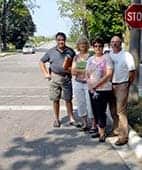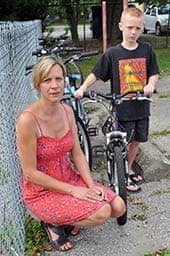Park Avenue’s Victorian homes, large lawns and canopy of old trees paint an idyllic picture, but residents say a growing surge in traffic is changing the character of the Elmira neighbourhood. Moreover, large trucks and speeding cars pose a growing safety threat.
Their concerns have met with some sympathy but absolutely no action from Woolwich Township.
![Park Street residents Ken Gallipeau, Lois Weber, and Donna and Peter Fulcher want to see traffic-calming measures in their Elmira neighbourhood. [steve kannon / the observer]](https://www.observerxtra.com/content/images/wp-content/uploads/2013/08/post_parkstresidents.jpg)
“It’s just crazy with speed. It’s a real safety concern,” said Park Avenue resident Ken Gallipeau, who’s been vocal in bringing the issue to the township, where, thus far, he “gets the feeling that this is not a priority.”
He and some of his neighbours say the problem has grown worse in the last decade as the former Elmira Raceway lands were turned into a residential subdivision. Park Avenue and some of the other east-west roads leading into the subdivisions have become a favourite route for residents looking to move quickly from their homes to roadways out of town.
The situation has become worse since Church Street was closed, causing drivers to find alternative routes, said Gallipeau, noting the traffic is a harbinger of what’s to come when some 1,700 new homes are built on the north side of Church Street – drivers will want to get from the northwest side of town to Arthur Street heading to Waterloo, avoiding downtown as they do it.
A resident for 33 years, Peter Fulcher has seen the traffic grow, changing the once-tranquil neighbourhood.
“Snyder [Avenue] is like a highway with all the people from the new Elmira – that’s what we call it – coming through here.”
“We don’t sit on our front porch anymore because of the traffic,” added his wife, Donna.
While noting that some increase in traffic was inevitable with the growth, the residents argue the township needs to implement some traffic-calming measures to force drivers to slow down.
“The big concern is the speed,” said Peter Fulcher.
“The speed limit is 50 – that’s 30 miles an hour, right? Well, they’re going a lot faster than that,” said Ken Stahlbaum, a resident of Park Avenue since 1961.
Richard Sigurdson, Woolwich’s manager of engineering, has fielded calls from concerned residents.
The township carried out a traffic and speed count earlier in the summer, part of an ongoing analysis of hundreds of locations, he said. The data will be compiled and compared to the last survey in 2003, with a report likely in the fall. The Park Avenue concerns are shared in many spots around the township, he noted.
“We have a significant list of similar concerns from other streets. As the township grows, we receive many more of these requests.”
Typically, they’re handled on a first-come, first-served basis. Remedies, if any, are carried out only if the traffic studies indicate a need. The numbers have to show enough of a problem to consider measures such as speed humps, lane-narrowing or all way stops.
“Only if there’s a demonstrated problem,” said Sigurdson in an interview Wednesday, arguing against calls for the use of all-way stops – at the intersection of Snyder and Park avenues, in this case.
A four-way stop can actually create more problems, he said. If overused, drivers ignore them, putting pedestrians in danger because they expect cars to stop. As well, drivers sometimes speed up between the signs in order to make up for time lost at the stops.
“That certainly would not be the preferred option,” he said of a four-way stop.
All the talk of counts and warrants doesn’t impress the residents, however. They’ve seen traffic volumes increase steadily, citing an increase in speeding drivers and the number of collisions in the neighbourhood as much better reasons for action.
“It was a quiet street that had hardly any traffic 10 years ago. Now, there are a lot more problems,” said Lois Weber.
“We’ve got to get people slowing down. We’ve got to get people stopping at the stop signs,” added Gallipeau.









